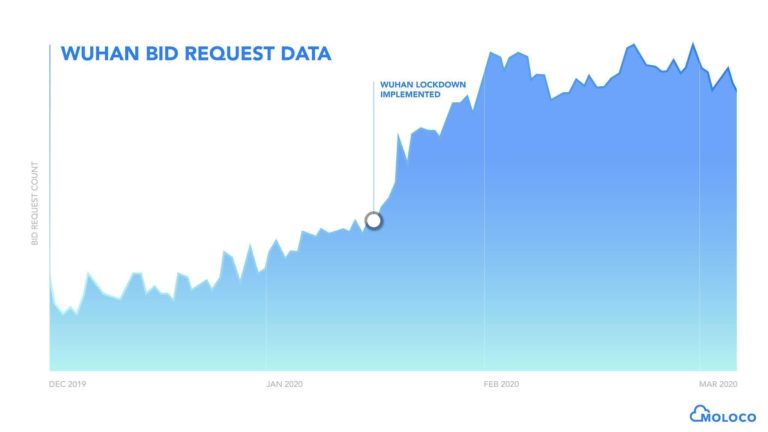30-second summary:
- COVID has triggered a massive spike in digital shopping, especially on mobile.
- Pursuing customers exclusively via Facebook & Google ignores the larger opportunity.
- Consolidated competition in walled gardens correlates to reduced returns for all.
- OpenRTB technologies provide a powerful programmatic alternative.
- The window of programmatic first-mover advantage is closing.
For ecommerce marketers, the 2020 holiday shopping season represents an unprecedented opportunity.
COVID-19 has hurled us five years into the future in terms of addressable market size, and giants like Amazon have doubled their profits. The industry at large is expected to grow by at least 20% before the end of the year, with much of that growth attributed to mobile shoppers.
On the other hand, high unemployment, presidential election dynamics and a growing national debt could lead to a shorter, flatter, myopic holiday shopping season in the United States, traditionally a tentpole market.
This confluence of cultural, technical, and macroeconomic factors has given ecommerce marketers an important choice to make when it comes to their paid mobile advertising: Should they seek out new opportunities to take advantage of the expanding market? Or double down on what’s worked in the past?
Consolidation vs diversity
Setting aside labor controversies and political boycotts, responding to growing demand by increasing spend with known entities like Facebook and Google is objectively attractive.
Engagement is up, albeit largely in areas not monetized by ads, (Read more...) major advertisers are slashing their spend with the duopoly as they try to weather the storm at reduced costs, resulting in less competition when it comes to bidding on impressions.
Unfortunately, benefits like these are unlikely to reach mobile ecommerce marketers, as theirs remains one of the few industries to actually benefit from the pandemic.
It’s more likely that the momentum of last year’s 20% year-over-year increase in online holiday shopping will be further accelerated, producing higher media costs for ecommerce marketers as more businesses compete for the same audiences.
In fact, overall Facebook CPMs have already increased 40 to 50% since January of 2020.
Consolidation is a liability. It creates a negative correlation between market competition and return on ad spend (ROAS) with no chance of offsetting costs.
The real opportunity for ecommerce marketers this holiday season lies in spending less within walled gardens and instead investing in a plurality of solutions that treat the mobile ecosystem as a constellation of communities, each with their own unique advantages to offer.
Only through diversity can marketers outmaneuver their competitors and insulate themselves from the dangers of an overly conservative advertising budget.
Beyond Facebook and Instagram
As marketers, we do ourselves an immense disservice in limiting what we consider “mobile” to just the Facebook and Instagram apps. While it may have been accurate as a shorthand for where the majority of mobile engagement was directed years ago, today it’s lazy, and ignores the truth of the new digital world taking shape.
As more people than ever rely on their mobile devices to play, connect, explore and stay informed in a time of uncertainty, the entire mobile ecosystem is bustling with activity.
Lockdowns have introduced vast amounts of unplanned mobile surf time, resulting in a 20% jump in mobile app activity across the board. Mobile game downloads are up 39% year-over-year, a category in which 63% of all revenue is generated by ad impressions.
At the same time, streaming platforms like Twitch have seen an influx of new audiences and creators seeking meaningful connection. Emerging social media platforms like TikTok are surging with user generated content and even regional news sites are seeing traffic levels rise by as much as 150% over their seasonal average.
Embracing first mover advantage
Combined, this mass exodus to digital environments has resulted in an immense increase in requests for advertisements from publishers as mobile users tap, swipe, and scroll in record numbers. As mobile publishers of all kinds eagerly seek to monetize their growing user bases, countless opportunities for cost-effective user acquisition are emerging.
Realizing these opportunities requires that mobile marketers take control of their budgets, venture outside their comfort zones, and embrace ownership of their success instead of entrusting it to the algorithms of digital advertising giants.
By familiarizing themselves with the underlying technologies that power the greater mobile advertising ecosystem, marketers can equip themselves with the tools necessary to succeed.
Good marketing is about calculated risk-taking and believe it or not, there was a time when allocating budget for Facebook video ads would have been considered a risky move. The brave few who took the risk enjoyed immense rewards as a result.
The situation today is much the same: Only by embracing new channels and open market solutions can marketers afford themselves the agility necessary to compensate for rising media prices, outmaneuver their competition, and take the risks needed to succeed this holiday season and beyond.
Thomas Shin is Head of Americas for MOLOCO, a mobile DSP based in Silicon Valley that was just ranked #5 by the Appsflyer Performance Index for Non-Gaming Retention. An avid ad tech fan, Thomas brings 25 years of experience in digital marketing as an advertiser, product manager, and sales leader. He spent the last 10 years at companies such as Facebook, Efficient Frontier/Adobe, and MediaMath where he pioneered ad product development, led ecommerce and disruptor teams and now focuses on the intersection of programmatic, social media, and the mobile app ecosystem.


